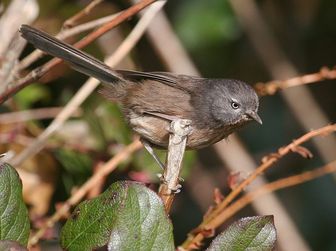Wrentit
Its systematics have been the subject of much debate, the Wrentit having been placed in many different families by different authors for as long as it has been known to science. Its common name reflects the uncertainty, and its external resemblance to both tits and wrens. It is by no means closely related to either however.

Original source: Transferred from en.wikipedia; transfer was stated to be made by User:Innotata. Original uploader was Matt Deres at en.wikipedia(Original text : http://www.flickr.com/photo_zoom.gne?id=109509845&size=l)
Author: Image taken by planephotoman,
The Wrentit is classified as Least Concern. Does not qualify for a more at risk category. Widespread and abundant taxa are included in this category.
The Wrentit is this hemisphere's only representative of the Babbler Family (Timaliidae) which is otherwise found in Europe, Africa, Asia, and Australia. How this isolated member of a family of such worldwide distribution should be found only on the Pacific coast of North America is a remarkable example of adventurous colonization by a species. More
The Wrentit, Chamaea fasciata, is a small bird that lives in chaparral and bushland. It is the only species in the genus Chamaea. Its systematics have been the subject of much debate, the Wrentit having been placed in many different families by different authors for as long as it has been known to science. Its common name reflects the uncertainty, and its external resemblance to both tits and wrens. It is by no means closely related to either however. More
Wrentit: Resident from the Columbia River on the northern border of Oregon southward along coastal chaparral into Baja California and into the Sierra Nevada foothills of California. Chaparral, shrubs, and brush are preferred habitats. Listen to Call Voice Text "pit-pit-pit-tr-r-r-r-r-r-r-r", "peep-peep-peep-pee-pee-peepeepeepeprrr" Interesting Facts * The Wrentit was first described in 1845 by William Gambel, an American naturalist and collector. More
A common bird of the Pacific Coast chaparral, the Wrentit can be difficult to see as it skulks through the dense scrub. It is the only American representative of the mostly Asian family of babblers (Timaliidae). More
of Sibley and Ahlquist suggests the wrentit is the only New World babbler, whose ancestors crossed the Bering land bridge in the mid-Miocene (15–20 million years ago). Sibley and Ahlquist do place it in its own tribe, Chamaeini. OTHER COMMON NAMES French: Cama brune; German: Chaparraltimalie. PHYSICAL CHARACTERISTICS 6.3 in (16 cm); 0.5 oz (14 g). Gray (southern) or brown (northern) compact bird with long tail (usually held up), pale eyes, and small, sharp bill. More
Wrentits are the only member of the Babbler Family (Timaliidae) living in our hemisphere. Their range extends south of the Columbia River in Oregon along the Pacific Coast to Northern Baja California. According to enature.com, "the Wrentit spends all of its adult life within the territory chosen in its first year. More
A Wrentit who hopped briefly out of the bushes in the Native Fragment area near the Sycamore Tennis Courts. Photo by Jason Finley, 8/31/05. It had been rustling out of sight inside the bush. Luckily I was ready with the camera when it came out! Photo by Jason Finley, 8/31/05. Wrentit illustration. -Illustration by Robert C. More
The wrentit is a little native bird of California. Its head, beak, and eyes resemble those of a tit, but its long tail is held at almost a right angle to its body like a wren. It is the only American member of the mostly Asian family of babblers (Timaliidae). How it got here is a mystery. More
with a long tail, the wrentit calls harshly and sings loudly in thick brush, where pairs forage for fruit and insects. Learn more about "wrentit" Citations - MLA Style: "wrentit." Encyclopædia Britannica. 2010. Encyclopædia Britannica Online. 17 May. 2010 . APA Style:wrentit. (2010). In Encyclopædia Britannica. Retrieved May 17, 2010, from Encyclopædia Britannica Online: http://www.britannica. More
Given its retiring nature and loud voice, the Wrentit is more likely to be detected by its call than by sight. The Wrentit has been variously placed in its own family, the Chamaeidae, or with the long-tailed tits (Aegithalidae), the true tits and chickadees (Paridae), the "Old World warblers" (Sylviidae), and with the "Old World babblers" (Timaliidae). The American Ornithologists' Union places the Wrentit in the latter family (AOU 1998 More
A Coast live Oak with a Wrentit in it.Wrentit at the bird bath.The Wrentit is a small brown bird that often holds its long tail at almost a right angle to its body in a similar fashion to a wren. The Wrentit has a song that is familiar in any chaparral community it sounds like a bouncing ball. The sound gets shorter and faster. Something like this: wren—tit—tit-tit-tit-t-t-t. wrentits prefer the chaparral plant community. More
9 d for Wrentits at Palomarin (range = 11-18, mode = 15, SD = 0.81, n = 192). DEVELOPMENT AT HATCHING: Altricial and naked, eyes closed. NESTLING PERIOD: Mean nestling period from 242 nests at Palomarin was 14.6 d, mode 15, range 11-19, SD=1.5 (PRBO). PARENTAL CARE: Both parents. More
vues liamkestrel — 10 mai 2009 — A Wrentit scolding for being too close to a probable nest. May 9,2009 in Charmlee Park in Malibu CA. We didn't ... liamkestrel — 10 mai 2009 — A Wrentit scolding for being too close to a probable nest. May 9,2009 in Charmlee Park in Malibu CA. We didn't get a lot of species, but this park has been great for its native plants and Wrentits. The Monkey Flower (Mimulus) was keeping the Hummingbirds happy by being in full bloom. More

Original source: Blake Matheson
-Blake Matheson -Author: Blake Matheson
Permission: Some rights reserved
Family : Timaliidae
Genus : Chamaea
Species : fasciata
Authority : (Gambel, 1845)

